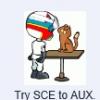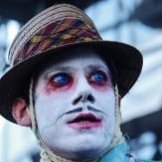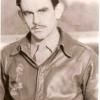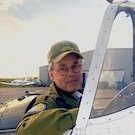Search the Community
Showing results for tags 'Raiden'.
-
Another Hasegawa kit I completed around the same time as my last post. This kit was part of the same line as my Tony, using 70s plastic but released with a new box in 1980. Just like the Tony, this kit gave me no issues in assembly and it really cemented my opinion of Hasegawa. This was painted in AK Real Colors' IJN D1 Green Black on the upper surfaces and Hairyokushoku on the undersides. This kit actually didn't come with any decals so I had to use leftover ones from my Tony. The fuselage roundels should be slightly larger but I worked with what I had. This was long before I would have felt comfortable enough to try masking off and painting the correct size (something I still may be hesitant to do). ----------------------------------------------------------------------------------------------------------------------------------------------------------------------------------------------------------------------------------------- The Raiden was designed by Jiro Hirikoshi, the same man who designed the more famous A6M Zero, the fighter that gave Japan aerial superiority in the early stages of the war. The Raiden was built as an Interceptor, and after a long delay in production beginning in 1942, it entered service at the end of '43 until the Japanese surrender. As an interceptor, the Raiden was used to defend Japanese territory against Allied B-29 Superfortress bombers, and was successful in doing so for a short time until the Allies began night bombing runs in March of 1945. This, combined with a lack of numbers in production, limited the Raiden's effectiveness.
- 10 replies
-
- 23
-

-
Hi mates. This one was meant to be a "quick" project...but my mojo went awol, and here it is: I hope I can finish it, and this nice GB can give me the right push!
-
Whilst building my current Zero I've found Japanese aircraft a lot more appealing so now considering building a Raiden as well but not sure which of the available kits in 72nd scale would be the best to go for. My understanding is that there are currently two options, either the Hasegawa J2M3 or the Sword J2M2 but which is the better in terms of accuracy and build please? Regards Colin.
-
Hello guys, here's my sixteenth model since the beginning of the quarentine. It's the Tamiya 1:48 Raiden with the striking orange-yellow lightning bolts on the fuselage. I hope you enjoy the photos.
-
Hi all. Number six for the year and the final one for 2019. The 1/48 Hasegawa J2M3 Raiden. I started this one almost two years ago however a disaster at the painting stage shelved it for almost 18 months. I picked it up about three weeks ago and finished it this evening. (10pm AEST, 31/12/19). I chopped open the canopy, added ResinArt wheels and exhausts, painted the roundels and used Aeromaster decals for stencils and ancillary markings. I really enjoyed the dinged up green on this one. There's so much scope for weathering with Japanese WW2 era subjects and this is a great subject to apply it to. Happy New Year and safe 2020 to all. Mick
-
Hi folks. I've had this one sitting on the shelf with Tamiya AS-12 on it for a while so I decided to finally get some colour onto it. It's amazing how many models are ini a state where paint can be applied and then a day later end up looking almost complete. It's my first real go at trying the AK Chipping Effects fluid besides on accessories. The colours used are lacquers by Mr Color which I absolutely love. Their coverage and applications characteristics are just great. They are a tad smelly though nothing a paint mask can't sort out. In order of application of colour Tamiya AS-12 AK Chipping Effects Mr Color 122 RLM 82 Light Green Mr Color 126 Cockpit Color (Mitsubishi) Mr COlor 124 Dark Green (Mitsubishi) The cowl was masked and then got the same treatment as the main colour. Mr Color actually do a Cowl Color which is #125. The chipping was done by scrubbing and chipping away at the paint with a stump paint brush and a pottery tool. By rolling the pottery tool (kind of like a nail) on it's edge you can get some pretty good random chips over large, flat area. The gloss a Tamiya X-22 thinned with lacquer thinner. One thing I do after I've put it down is to hit it with neat Tamiya Lacquer thinner. It ends looking like glass and is super smooth, excellent for decal application. The underside grey goes on tomorrow. Thanks, Michael
-
Hi Everyone. I have just finished my OOB build of 1/48 Hasegawa Mitsubishi J2M3 Raiden, (Serial No. 3008), captured on the emergency airstrip at Dewey Boulevard, Manila in the Philippines. Hope you enjoy the pic`s, thanks for looking Cheers
- 17 replies
-
- 37
-

-

-
J2M3 Raiden Seat with Belts, for Hasegawa kit 1:72 CMK Somewhat out of the blue, Special Hobby have issued a replacement resin seat for Hasegawa's Mitsubishi J2M3 Raiden kit. I for one am pleased about this, not least because I have a dual combo edition of this kit in my stash, acquired for a keen price from the excellent Hamex kit swap. The seat is nicely detailed and has harnesses cast in place. The quality of casting is top-notch too, with no bubbles of flaws in evidence. If you have the Hasegawa Raiden, then this will make a simple but effective upgrade to the cockpit. Highly recommended. Review sample courtesy of
-
For this Model - I used the Hasegawa Mitsubishi Raiden J2M3 1/48 Model kit 09667 “ 302nd Flying Group “ and used the following Aftermarket parts used in the construction: 2 Eduard PE sets - 48 201 and FE117 - both are essential to buy as they each have etch parts that the other doesn’t offer N1K2-J etch set to supply extra handles and switches Eduard Express Mask EX 095 and Squadron Vac Canopy 9587 Fukuya Brass pitot tube ( and the metal end is hollow - so more accurate ) Airmaster Brass 20mm Cannon Barrels (these are highly recommended as they have hollow ends - and are far more accurate and realistic ) Moskit Exhausts ( extremely rare - now - and out of production for over 15 years ) The essential super-detail modifications which I made was adding copper wire (taken from a piece of ordinary insulated wire) to construct the 2 Radio Electrical cables, and at the sides of the cockpit, which I found were necessary due to a close study of the cockpit drawings and photos kindly supplied by the Japanese Aviation expert, Mr Jim Long. The kit pitot tube was replaced by the Fukuya Brass Pitot tube and the Eduard express mask Ex 48 095 was used to mask the canopy frames. I used the out-of-print 1/48 Decals by Aeromaster “ Empire Defenders Part 4 “ which was the J2M3 belonging to the 332 Naval Air Group based at Naruo Airbase in 1945. I used Modellers putty to construct the triangular Leather Headrest which the actual aircraft was fitted with, and was delighted with the result. After I applied the Copper wire at the fuselage sides (fitted to part J6), I then fitted an extra smaller receiver box (scatch built) fitted behind the kit supplied radio (part J14) which the real aircraft was equipped with. Please note the radio electrical cable emerged in 2 places on the right side of the aircraft (see photos) and went around the radio. I used 4 extra handles and switches to the rear of part J8 as the actual aircraft was fitted with 4 extra control handles that are not on the Hasegawa parts - or offered by Eduard used the technique of pre-shading to avoid the purely green boring look to green painted Japanese aircraft and used black Humbrol paint to achieve a weathered look to the Model using my Aztek to apply engine exhaust and cannon barrel staining to the wings and fuselage. ][/url] I love the unusual look of this Japanese aircraft. My only gripe with the model kit is why they don’t supply the kit with a canopy that can be opened, as the Squadron canopy must be purchased to allow you to do this - the same gripe as for the Hasegawa Ki.61/ Ki.100 Tony’s canopy.
- 14 replies
-
- 25
-

-
- 1/48
- Mitsubishi
-
(and 1 more)
Tagged with:
-
Hello gents, I do at times wonder what guides us in the choices we make with regard to the kits that we build; I don't generally step outside the boundaries of the proper scale for model aircraft - 1/72 of course - and yet somehow I have found myself in possession of the Hasgawa 1/32 J2M3 Raiden as well as the Tamiya A6M2 Zero in the same scale. I do have a fondness for both aircraft obviously or else I shouldn't have bought them in the first place, I like the elegant lines of the Zero and the slightly stubby but powerful terrier-like look of the Raiden - in addition its Allied reporting name was 'Jack', the same as my own terrier (his name I mean, he was not involved in the Second World War and had no Allied code-name; also I like to think that if he had been involved he would at least have been on 'our' side but sometimes his behaviour does lead me to wonder...) Anyway as they say, we are where we are, and thanks to a scandalously low-price offer from Tiger Hobbies I am now the proud but perhaps a little bemused owner of this: ... and the box contains the following; instructions and transfers: ... and the following sprues: Some points of interest from my initial cursory look include several optional parts including a different set of propellers, a really nice pilot figure with three optional heads and a choice of arms, a one-piece slide-moulded forward cowling and optional open or closed canopy parts. I didn't really have anything in the way of references but fortunately Nick Millman's Aviation of Japan blog has a .pdf available of colour notes for the Raiden which is done in his usual exactingly thorough way and will, I have no doubt, prove invaluable. It's on the right-hand side of the webpage, scroll down a bit if you are interested in obtaining a copy. I'll have a peruse of that and work out what paints I need to use. Cheers, Stew
-
Hi guys!. Japanese Thunderbolt from the box, only seatbelts and few cables added into cockpit. Superb kit, in terms of fit as excellent as Tamiya. I forgot to add antenna wire, but 15 minutes of work will fix that.
- 12 replies
-
- 30
-

-

-
Doing this model I experienced mild disappointment Hasegawa. The model is a nice fit, but when it came to the red cabin, I realized that is not the best cast. On the windscreen are not nice Bases were defined, and the whole cabin was slightly twisted. Therefore I had a big problem that I install properly. Better than I could. The plane on the shelf looks quite correctly, while the camera shows the error. Here's the picture:
- 7 replies
-
- 21
-

-
- Raiden
- Mitsubishi
-
(and 1 more)
Tagged with:
-
Hi, Old kit - not produced since years. The Tamiya's 1/72 Mitsubishi J2M3 Raiden (Jack) in markings of Tainan Air Corps of Imperial Japan Navy, Taiwan 1944. Pilot Lt.Yoshihiro Aoki (markings from box). I only outdust her and softer decals, add some part of missing number from one side of rudder, cover with Vallejo matt varnish (not so well mixed to produce a bit satin effect ) I left original Tamiya's very dark hinomarus. This is my another very old model - plus fourty years from construction. I remember that I added mach later then I did model the exploitation/weathering - but it was still before 1980....Really - I made this model when I was going to school (age of ~16) - now my grandaughter will go school this year. So... something had happend inbetween - about 400 other models among other things. Comments welcome Regards Jerzy-Wojtek
- 3 replies
-
- 3
-

-
- Mitsubishi J2M3
- Raiden
-
(and 1 more)
Tagged with:
-
I am trying to get out of my modeling funk here lately as I have stalled on a few builds, Mosquito, Mustang, Harrier (sheesh the list is getting long) and others. So to try to get back in the swing of things I stepped out of my box and built a couple of Revell 1/144 tiger meet jets. I normally only do WWII aircraft (yeah, I know the list above had a Harrier, contradictions are my nature), so this helped. However, I was pleasantly surprised when the Zoukei-Mura 1/32 J2M3 Raiden arrived at my office. I had pre-ordered it who knows when (got to stop late night internet shopping when I’m bored), but it had been so long ago, I had forgot I had ordered it. First impressions out of the box were “Can’t believe the level of detail and the amount of parts!” With the kit, apparently, I had ordered the photo-etch interior set and the metal gun barrels; who knew? By the time I had perused the manual (I can’t be the only one out there that must open the box, look and feel some of the plastic, gaze at the decals, and then go through the entire manual even if I have no intention of building the darn thing for years. Just have to do it when I first get a kit.), I was hooked and had to start on it right away. Now, I have purchased every one of ZMs 1/32 models to date with the exception of the Mustang. (And they are all sitting in the stash to do.) Why this one made me want to immediately start, can’t tell you. So, it was break out the Japanese paints, (where is the aotake?), nippers, glue, filing sticks and start. Now, there is a difference between the first perusal of the instructions and actually getting them out to begin building. By the way, the instruction manual so far is great. Very detailed, very informative and gives you finished examples of what you should end up with which helps me actually end up with a fair resemblance to what it should be. Anyway, I am going build this as per the manual, mainly out of the box and then see how much of the effort actually pays off as being able to be seen once built. I figure a lot of what is done will only be seen in the photos I take as it is being built. Once built, I hope a large percent still is visible, but I have my doubts. So, here goes. And, if I put too much detail and too many pictures, let me know. Going to do this step by step as per the instructions. If I should start skipping steps and just show the finished product, let me know. The first step is the engines not the cockpit. Since I am assembling with the view everything will be visible, my first step of putting the cylinders together was very disappointing. There are gaps at every end of every cylinder. Now maybe this is my fault with construction, but I doubt it since both cylinders have the gaps. So out with the filler and fun and games begin. If this is typical of the fit, then this will be a frustrating build. All the gaps are filled and now the cylinders and different engine parts are ready for painting. here are the first stages of paint laid down prior to weathering. Put the cylinders together and gave them a dark wash, Added the push rods, housing and propeller shaft. All the parts since putting the cylinders together have fit perfectly and have meshed quite well. The detail is still amazing. But, I can start to see much of the build will not be seen when completed. An example is the engine pistons and connecting rods. But, I am determined to paint and finish all that there is even though it may never see the light of day. The exhaust pipes get a base metallic coat to begin their finish. As the paint on the exhausts dry, I finished weathering the cylinders/housing/propeller shaft assembly. Next after weathering the exhausts, I attached them to the engine. I then attached the engine mount cover, various bits and pieces behind it, engine mount and carburetor vent and intake. Now is where I become a bit anal. I really want this to be a good build (I would like it to be great, but I know my limitations, good is a maybe achievable goal.) On the cowl flap assembly, there are lightening holes represented. Thought it would be a good idea to actually drill them out. It was great fun. What I am most proud of is I didn’t break the part as I was drilling it. Anyway, the left part has the drilled holes; the right part is the kit representation. Once it is put together, it probably won’t make a lick of difference. Now on to drilling out the other side. Here is the back of the engine with the last of the bits and pieces added. And the engine is finished. So far, it looks like drilling the holes has helped. Will have to see how much is visible after final assembly. Next update will be the start of the cockpit.
- 62 replies
-
- 10
-

-
- Zoukei-Mura
- 1/32
-
(and 2 more)
Tagged with:
-
Sword is to release a 1/72nd Mitsubishi J2M2 Raiden model 11 (late version) kit - ref. SW72091 Source: http://www.hyperscale.com/2015/reviews/kits/swordpreviewbg_15.htm 2 decals versions: - 301st Naval Air Group,April 1944 Yokosuka AB/Kanagawa - 302st Naval Air Group,March 1944 Kisarazu AB/Chiba V.P.
- 2 replies
-
- 1/72
- Mitsubishi
- (and 4 more)
-
Mitsubishi J2M3 Raiden, (Jack) 1:32 Hasegawa History The J2M was designed by Jiro Horikoshi, creator of the A6M Zero to meet the 14-Shi (14th year of the Showa reign, or 1939) official specification. It was to be a strictly local-defence interceptor, intended to counter the threat of high-altitude bomber raids, and thus relied on speed, climb performance, and armament at the expense of manoeuvrability. The J2M was a sleek, but stubby craft with its over-sized Mitsubishi Kasei engine buried behind a long cowling, cooled by an intake fan and connected to the propeller with an extension shaft. Pilot visibility was poor, but a domed canopy introduced later in production partially alleviated this concern. Teething development problems stemming from the Kasei engine, unreliable propeller pitch change mechanism and the main undercarriage members led to a slowdown in production. A continual set of modifications resulted in new variants being introduced with the ultimate high-altitude variant, the J2M4 Model 34 flying for the first time in August 1944. It had a 1,420 hp Kasei 23c engine equipped with a turbo supercharger (mounted in the side of the fuselage just behind the engine) that allowed the rated power to be maintained up to 30,000 ft. Two upward-aimed, oblique-firing (aimed at seventy degrees) twenty mm cannons, mounted in the German Schräge Musik style, were fitted behind the cockpit with the four wing cannons retained. Unresolved difficulties with the turbo supercharger caused the project to be terminated after only two experimental J2M4s were built. The first few produced J2M2s were delivered to the development units in December 1942 but severe problems were encountered with the engines. Trials and improvements took almost a year and the first batch of the serial built J2M2 Model 11 was delivered to 381st Kokutai in December 1943. Parallel with the J2M2, production of the J2M3 Raiden Model 21 started. The first J2M3s appeared in October 1943 but deliveries to combat units started at the beginning of February 1944. The Raiden made its combat debut in June 1944 during the Battle of the Philippine Sea. Several J2Ms operated from Guam and Saipan and a small number of aircraft were deployed to the Philippines. Later, some J2Ms were based in chosen airfields for defending these areas and fighting against Soviet Naval Aviation units. Primarily designed to defend against the Boeing B-29 Superfortress, the lack of a turbocharger handicapped the aircraft at high altitude. However, its four-cannon armament supplied effective firepower and the use of dive and zoom tactics allowed it to score occasionally. Insufficient numbers and the American switch to night bombing in March 1945 limited its effectiveness. Two captured J2Ms were U.S. Technical Air Intelligence Command (TAIC) tested using 92 octane fuel plus methanol, with the J2M2 (Jack11) achieving a speed of 655 km/h (407 mph) at 5,520 m (17,400 ft), and J2M3 (Jack21) achieving a speed of 671 km/h (417 mph) at 4,980 m (16,600 ft). The Model This kit was originally released in 2011 as one of Hasegawas 70th anniversary release schedule. This version is released as a limited edition with the markings of aircraft from the 302nd Flying Group. Since the moulds are still fairly new there is no sign of wear, so no flash and only one or two moulding pips too. The moulding is very nicely done, with fine recessed panel lines and fastener details as we’ve come to expect from Hasegawa. There are eight sprues of grey styrene and three of clear plus four vinyl retainers. The instructions are relatively clear and easy to read, in an A4 sized booklet format. The build starts with the cockpit and the instrument panel, which is attached to the forward bulkhead has moulded instrument bezels, but uses four blocks of decals for the faces. Depending on how these settle it might be an idea to fit each face separately, much like using an Airscale set. A drop of Aqua gloss or Kleer can be used to seal the decals, with the added advantage of drying to look like the instrument glass. The seat bucket is fitted with a support arm each side whilst the rear bulkhead is adorned with the seat adjustment bracket, adjustment handle, headrest and rear armoured plate. The radio set is assembled from four parts and fitted to the rear shelf, which is then attached to the rear of the bulkhead, with the seat assembly attached to the front. The sidewalls have well defined details moulded onto them and this is enhanced with additional parts and decals. The cockpit floor is fitted with the a console on the port side which also has a couple of smaller parts fitted, followed by the throttle lever on the port side floor, rudder pedals, joystick, undercarriage and flap levers on the starboard floor. The sub-assemblies are then fitted together, creating the sturdy cockpit structure. There are two parts that look like harness attachments fitted one per side of the headrest support structure, but the harness will need to be sourced from an aftermarket company as it is not included in the kit. What the kit does include is a very well moulded multi part pilot, with front and rear torso, separate legs and arms, including an alternative right arm plus three styles of head, one with a mask and oxygen hose, one with the leather helmet open and one with the helmet fastened up. Fitted with the separate parachute pack and after a careful painting session it will make a nice addition to the completed model no matter what flying state it is in. If you’re not going to use the pilot then Hasegawa have provided a separate seat cushion to be fitted. With the cockpit and pilot assembled it’s onto the fuselage. There are five bulkheads of various sizes and shapes to be fitted to the starboard side followed by the cockpit assembly. Inside the port fuselage a square hole has to be opened up and a lever assembly passed through, I believe this may be a canopy opening lever and only used on two of the aircraft options. The fuselage can then be closed up. The wing assembly begins with the assembly of the front spar, rear bulkhead and adjoining structure. This is then attached to the single piece lower wing section with the spar just aft of the wheel wells. There is also a block to be attached between the well bays and two strengthening spars attached to the outer sections of the wing. Before fitting the upper wing sections it should be decided whether the external fuel tank is going to be used or not as the flashed over holes will need to be opened up in the lower wing. On the insides of the upper wing sections the gun troughs also need opening up. The upper wings can now be attached to the lower wing and two clear parts, which I presume are some form of formation lighting are fitted to the top of each upper wing. The fuselage assembly is attached to the wing assembly, whilst the two part horizontal tailplanes are attached to the rear fuselage. The gun barrels, gun fairings, pitot probe and clear navigation lights are now attached. Next up is the assembly of the main undercarriage, each made up of the main oleo, two part scissor link, two part tyre, poly retainer, inner and outer hubs and main bay door. The inner doors are attached to the fuselage with their associated retraction linkages while the outer doors are fitted to the outer edge of the bay adjacent to the oleo attachment. The tail wheel, tail cone and a pair of lower wing panels are attached, followed by the main undercarriage assemblies. The optional drop tank consists of two halves with separate horizontal tail fins. Once complete it can be attached to the aircraft, between the undercarriage bays. With the main structure complete it’s on with the powerplant. Firstly the modeller will need to decide which of the two types of propeller blades to use, either the standard type or the high performance type. Each of the separate blades are then fitted to the hub and enclosed with the spinner, while to the rear a locating propshaft is attached. The cowling is then completed with an air intake fitted to underside of the single piece cowling and two blanks to be fitted to the upper machine gun trough. The internal structure is then assembled from the ducting, fixed stator with poly retainer fitted and rotating fan blades. This structure is fitted to the inside of the cowling. The engine is made up of the front and rear cylinder banks, two sets of valve rods at the front plus the intake and exhaust manifolds to the rear. The completed engine is then attached to the fuselage followed by the cowling and finally the propeller. The build continues with the attachment of a clear “armoured windscreen” and support structure to the upper decking between the cockpit and the cowling, plus optional Type 4 or Type 98 gun sight. The main windscreen is fitted out with a pair of grab handles, and then fitted to the front of the cockpit once the upper deck assembly has been attached. The two separate gun bay panels for the upper wings are fitted followed by the aerial and side window support structure, side windows, and canopy, and that is the build complete. Decals The quite large decal sheet provides markings for three aircraft, each of the 302nd Fighter Group. the colour schemes are the same for each aircraft and only the serial numbers changed and the 1st option having a yellow band around the rear fuselage. The decals are all nicely printed, in good register and with very little carrier film, even around the instrument blocks. While the decals appear to have been gloss once they seem to have lost the gloss coat and are now quite matt. They should settle well though on a good gloss coat with suitable setting and softening solutions. followed by a coat of gloss varnish followed by a coat of matt varnish. Conclusion I’ve always liked the Raiden, and this is very nice looking kit of a great looking aircraft. This will also make for a good alternative to the complex ZM release and also a fair bit cheaper. If you are going to comment on this review, please don’t bang on about Hasegawa pricing, as this one is actually quite reasonable. The detail is superb out of the box, but if you want to go the extra mile then the usual companies already have aftermarket parts for this kit. So if you fancy having a Raiden in your collection you can’t really go wrong with this one. Highly recommended. Review sample courtesy of UK distributors for
-
Source: http://www.zoukeimur...tml#Ipms1211Lst After two years of research next Zoukei-Mura 1/32nd Super Wings Series will be a Mitsubishi J2M Raiden "Jack. V.P.
- 11 replies
-
- 1/32
- Mitsubishi
-
(and 4 more)
Tagged with:
-
Pretty well there - beautiful kit to build - hopefully to be published in a future edition of Military in Scale: Iain


















